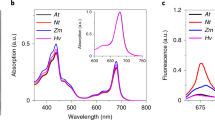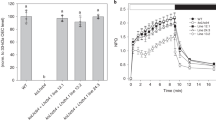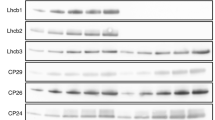Abstract
Photosystem II (PSII) is a key component of photosynthesis, the process of converting sunlight into the chemical energy of life. In plant cells, it forms a unique oligomeric macrostructure in membranes of the chloroplasts1. Several light-harvesting antenna complexes are organized precisely in the PSII macrostructure—the major trimeric complexes (LHCII)2 that bind 70% of PSII chlorophyll and three minor monomeric complexes3—which together form PSII supercomplexes4,5,6. The antenna complexes are essential for collecting sunlight and regulating photosynthesis7,8,9, but the relationship between these functions and their molecular architecture is unresolved. Here we report that antisense Arabidopsis plants lacking the proteins that form LHCII trimers10 have PSII supercomplexes with almost identical abundance and structure to those found in wild-type plants. The place of LHCII is taken by a normally minor and monomeric complex, CP26, which is synthesized in large amounts and organized into trimers. Trimerization is clearly not a specific attribute of LHCII. Our results highlight the importance of the PSII macrostructure: in the absence of one of its main components, another protein is recruited to allow it to assemble and function.
This is a preview of subscription content, access via your institution
Access options
Subscribe to this journal
Receive 51 print issues and online access
$199.00 per year
only $3.90 per issue
Buy this article
- Purchase on Springer Link
- Instant access to full article PDF
Prices may be subject to local taxes which are calculated during checkout




Similar content being viewed by others
References
Hankamer, B., Barber, J. & Boekema, E. J. Structure and membrane organisation of photosystem II in green plants. Annu. Rev. Plant Physiol. Plant Mol. Biol. 48, 641–671 (1997)
Kühlbrandt, W. & Wang, D. N. Three dimensional structure of plant light-harvesting complex by electron crystallography. Nature 350, 130–134 (1991)
Peter, G. F. & Thornber, J. P. Biochemical composition and organization of higher plant photosystem II light-harvesting pigment-proteins. J. Biol. Chem. 266, 16745–16754 (1991)
Boekema, E. J., Van Roon, H., Calkoen, F., Bassi, R. & Dekker, J. P. Multiple types of association of photosystem II and its light-harvesting antenna in partially solubilized photosystem II membranes. Biochemistry 38, 2233 (1999)
Boekema, E. J., Van Roon, H., Van Breemen, J. F. L. & Dekker, J. P. Supramolecular organization of photosystem II and its light-harvesting antenna in partially solubilized photosystem II membranes. Eur. J. Biochem. 266, 444–452 (1999)
Nield, J., Orlova, E. V., Morris, E. P., Gowen, B., Van Heel, M. & Barber, J. 3D map of the plant photosystem II supercomplex obtained by cryoelectron microscopy and single particle analysis. Nature Struct. Biol. 7, 44–47 (2000)
Jansson, S. The light-harvesting chlorophyll a/b-binding proteins. Biochim. Biophys. Acta 1184, 1–19 (1994)
Paulsen, H. Chlorophyll a/b binding proteins. Photochem. Photobiol. 62, 367–382 (1995)
Horton, P., Ruban, A. V. & Walters, R. G. Regulation of light harvesting in green plants. Annu. Rev. Plant Physiol. Plant Mol. Biol. 47, 655–684 (1996)
Andersson, J. et al. Absence of the main light harvesting complex of photosystem II affects photosynthetic function. Plant J. (in the press)
Barber, J. Photosystem II: a multisubunit membrane protein that oxidizes water. Curr. Opin. Struct. Biol. 12, 523–530 (2002)
Zouni, A. Crystal structure of photosystem II from Synechoccus elongatus at 3.8 Å resolution. Nature 409, 739–743 (2001)
Boekema, E. J., Van Breemen, J. F. L., Van Roon, H. & Dekker, J. P. Arrangement of photosystem II in crystalline macrodomains within the thylakoid membrane of green plant chloroplasts. J. Mol. Biol. 301, 1123–1133 (2000)
Hankamer, B. et al. Isolation and characterization of monomeric and dimeric photosystem II complexes from spinach and their relevance to the organisation of photosystem II in vivo. Eur. J. Biochem. 243, 422–429 (1997)
Allen, J. F. & Forsberg, J. Molecular recognition in thylakoid structure and function. Trends Plant Sci. 6, 317–326 (2001)
Haldrup, A., Jensen, P. E., Lunde, C. & Scheller, H. V. Balance of power: a view of the mechanism of photosynthetic state transitions. Trends Plant Sci. 6, 301–305 (2001)
Jansson, S. A guide to the Lhc genes and their relatives in Arabidopsis. Trends Plant Sci. 4, 236–240 (1999)
Croce, R., Canino, G., Ros, F. & Bassi, R. Chromophore organisation in the higher plant photosystem II antenna protein CP26. Biochemistry 41, 7334–7343 (2002)
Yakushevska, A. E. et al. Supramolecular organisation of photosystem II and its associated light harvesting antenna in Arabidopsis thaliana. Eur. J. Biochem. 268, 6020–6028 (2001)
Caffrari, S., Croce, R., Cattivelli, L. & Bassi, R. The Lhcb1, 2 and 3 gene products, components of the trimeric antenna complex of higher plant photosystem II, have distinct biochemical and spectroscopic properties. Proc. 12th Int. Congr. Photosyn., S31–034 (CSIRO, Canberra, 2001)
Hobe, S., Foster, R., Klingler, J. & Paulsen, H. N-proximal sequence motif in light-harvesting chlorophyll-a/b-binding protein is essential for trimerisation of the light harvesting chlorophyll a/b complex. Biochemistry 34, 10224–10228 (1995)
Kuttkat, A., Kartmann, A., Hobe, S. & Paulsen, H. The C-terminal domain of light-harvesting chlorophyll-a/b-binding protein is involved in the stabilisation of trimeric light harvesting complex. Eur. J. Biochem. 242, 288–292 (1996)
Garab, G. & Mustardy, L. Role of LHCII-containing macrodomains in the structure, function and dynamics of grana. Aust. J. Plant Physiol. 27, 648–658 (1999)
Bibby, T., Nield, J. & Barber, J. Iron deficiency induces the formation of an antenna ring around trimeric photosystem I in cyanobacteria. Nature 412, 743–745 (2001)
Boekema, E. J. et al. A giant chlorophyll-protein complex induced by iron deficiency in cyanobacteria. Nature 412, 745–748 (2001)
Walters, R. G., Rogers, J. J. M., Shephard, F. & Horton, P. Acclimation of Arabidopsis thaliana to the light environment: the role of photoreceptors. Planta 209, 517–527 (1999)
Berthold, D. A., Babcock, G. T. & Yocum, C. F. A highly resolved, oxygen-evolving photosystem II preparation from spinach thylakoid membranes. EPR and electron transport properties. FEBS Lett. 134, 231–234 (1981)
Ruban, A. V., Lee, P. J., Wentworth, M., Young, A. J. & Horton, P. Determination of the stoichiometry and strength of binding of xanthophylls to the photosystem II light harvesting complexes. J. Biol. Chem. 274, 10458–10465 (1999)
Laemmli, U. K. Cleavage of structural proteins during the assembly of the head of bacteriophage T4. Nature 227, 680–685 (1970)
Andersson, J., Walters, R. G., Horton, P. & Jansson, S. Antisense inhibition of the photosynthetic antenna proteins CP29 and CP26: implications for the mechanism of protective energy dissipation. Plant Cell 13, 1193–1204 (2001)
Acknowledgements
We wish to thank R. Walters for discussions. This work was supported by the UK Biotechnology and Biological Sciences Research Council, the UK Joint Infrastructure Fund, the Netherlands Foundation for Scientific Research (NWO) through the Foundation for Life and Earth Sciences (ALW), and the Swedish Research Council for Environment, Agricultural Sciences and Spatial Planning and the Foundation for Strategic Research.
Author information
Authors and Affiliations
Corresponding author
Ethics declarations
Competing interests
The authors declare that they have no competing financial interests.
Rights and permissions
About this article
Cite this article
Ruban, A., Wentworth, M., Yakushevska, A. et al. Plants lacking the main light-harvesting complex retain photosystem II macro-organization. Nature 421, 648–652 (2003). https://doi.org/10.1038/nature01344
Received:
Accepted:
Issue Date:
DOI: https://doi.org/10.1038/nature01344
This article is cited by
-
Demethylation alters transcriptome profiling of buds and leaves in ‘Kyoho’ grape
BMC Plant Biology (2020)
-
Disentangling the sites of non-photochemical quenching in vascular plants
Nature Plants (2019)
-
What proteomics can reveal about plant–virus interactions? Photosynthesis-related proteins on the spotlight
Theoretical and Experimental Plant Physiology (2019)
-
Transcriptional regulation of chilling stress responsive long noncoding RNAs in Populus simonii
Trees (2019)
-
Loss of LHCI system affects LHCII re-distribution between thylakoid domains upon state transitions
Photosynthesis Research (2018)
Comments
By submitting a comment you agree to abide by our Terms and Community Guidelines. If you find something abusive or that does not comply with our terms or guidelines please flag it as inappropriate.



